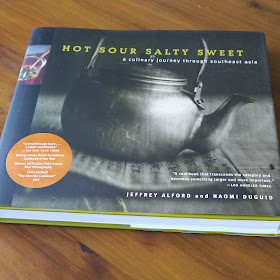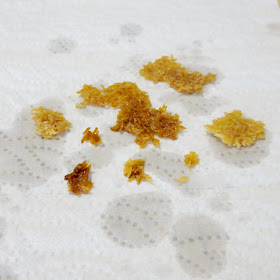The Setting: An apartment in need of a good vacuuming, as grains of white rice and other bits of debris from the weekend's culinary adventures are surely lurking in places where a curious, crawling monster is certain to find them.
The Soundtrack: Winds, raging outside my open window to a tune that the wildly rollicking tree limbs never knew they could play.
Steaming up the (microwave) Oven: Water for tea; It's a Lemon Zinger kind of day.
The Scenario: If you read the reference in my last post to a sheet of rice in my oven, you may have wondered what that was all about. You may have even wondered why the heck it was taking me so long to post about it as promised.
Well, today I am pleased to answer those questions, and in doing so, to invite you on a tasty trip down the Mekong River, as we dive into Hot Sour Salty Sweet (a Culinary Journey through Southeast Asia) by Jeffrey Alford and Naomi Duguid.
When I began to peruse this enormous culinary tome that reads half like a cookbook and half like an anthropological travel guide through Southeast Asia, I could tell it would take a while to select the five or so recipes I'd post on the blog.
Where to begin?!
Should I approach the recipe selection geographically, beginning with a dish from China or Myanmar and working my way down through Laos, Thailand, Cambodia, and Vietnam?
Should I stick with one region and explore it in depth?
I decided, at last, to approach the task as the book does, organizing recipes into standard categories of appetizers, salads, main courses, and desserts, and celebrating the ties the unique regional cuisines share with each other through the artful mingling of tastes: hot, sour, salty, and sweet.
Today I offer you a delicious appetizer of nam mi he man, or Grilled Tomato Salsa, from the Dai area of Southern Yunnan, China; and khao tang, or Crispy Rice Crackers, from Laos and Thailand.
These dishes, as you would expect, primarily play up the tastes of salty and hot, but charring the garlic and tomatoes before making the incredibly simple salsa helps to slightly concentrate and highlight their inherent sweetness as well.
With a flavor somewhat reminiscent of homemade popcorn, the Thai-Lao Crispy Rice Crackers are a delightful alternative to tortilla chips...if, that is, you can manage to make them.
It took me three tries (and most of the weekend), but my final batch was a big success. Check out the end of the post for my blooper reel and tips to help you avoid my blunders.
The following recipes are reprinted with permission from Artisan Books; I have added my notes in red.
Grilled Tomato Salsa (nam mi he man--Dai area of Southern Yunnan)
4 cloves garlic
3 medium juicy tomatoes
1 to 2 Serrano or bird chiles, minced (optional) I used 1 Serrano with the seeds and membranes
1/2 tsp salt, or to taste
1/2 cup chopped coriander (cilantro)
Heat a charcoal or gas grill. Place the garlic and tomatoes on a fine-mesh rack on the grill and grill until well blackened in spots on one side, then use tongs to turn them. Continue to cook, turning the tomatoes as necessary to expose all sides to the heat, until the garlic and tomatoes are well scorched and softened, 8-10 minutes. Alternatively (I used this method), heat a heavy skillet over high heat. Place the garlic and tomatoes in the skillet and lower the heat to medium-high.
As soon as the garlic and tomatoes blacken on one side, use tongs to turn them and cook, until well scorched and softened, 8 to 10 minutes.
Peel the garlic, chop or mash, and place in a food processor. Coarsely chop the tomatoes, saving the juice, and add the tomatoes and juice to the processor. Add the chiles, if using, and pulse several times to blend; do not process to a puree. Transfer to a bowl and stir in the salt. Store refrigerated no more than 2 days.
Stir in the coriander just before serving.
Makes 1 1/2 cups salsa.
Excerpted from Hot Sour Salty Sweet by Jeffrey Alford and Naomi Duguid (Artisan Books). Copyright 2000.
Thai-Lao Crispy Rice Crackers (khao tang--Laos, Thailand)
2 cups or more just-cooked jasmine rice I used 2 cups "enriched white long grain rice"
Peanut or other oil for deep-frying I used peanut oil
Use warm to hot rice. With a rice paddle or wooden spoon, spread rice onto a lightly oiled baking sheet to make a layer about 1/2 inch thick. Press down with your paddle to compact the rice so that it sticks together. Don't worry about ragged edges, as you will be breaking up the rice into large crackers after it dries. My rice was very sticky and hard to spread out; with my final batch I lined the baking sheet with parchment paper, and I found that if I wetted my hands and used them to gently pat out the rice, re-wetting as necessary, the rice was easier to work with--just be careful, as the rice is hot. Also, press the grains so that they stick together, but avoid compacting the grains too much, as this results in tougher crackers.
Place the baking sheet in a preheated 350-degree F oven and immediately lower the temperature to 250 degrees F. Let dry for 3 to 4 hours. The bottom will be lightly browned. I left my final batch in for 2 1/2 hours. The top was drier and more off-white in color, while the bottom was stickier and whiter.
When the rice is dry, lift it off the baking sheet in pieces.
Break it into smaller pieces (about 2 inches across, or as you please), then store well sealed in a plastic bag until ready to use. I waited a day before frying my successful batch.
To fry the crackers, heat 2 to 3 inches of peanut oil in a large well-balanced wok, deep fryer, or large heavy pot to 325 to 350 degrees F.
To test the temperature, drop a small piece of fried (dried) rice cake into the oil: It should sink to the bottom and immediately float back to the surface without burning or crisping. Adjust the heat as necessary.
Add several pieces of dried rice cracker to the hot oil and watch as the rice grains swell up. When the first sides stop swelling, turn them over and cook on the other side until well puffed and just starting to brown (about 30 seconds in all). Use a slotted spoon to remove them immediately to a paper towel-lined platter or rack to drain.
Gather up any small broken pieces; these make delicious croutons. Fry the remaining pieces of rice cracker the same way, making sure that the oil is hot enough each time. Serve hot and fresh, to accompany soup or salsa. Store in a cool place for no more than a week.
Excerpted from Hot Sour Salty Sweet by Jeffrey Alford and Naomi Duguid (Artisan Books). Copyright 2000.
Bloopers
I admit I've been on Hoosband-enforced rice-cooking probation for most of my marriage due to my lack of finesse with the finicky grain. So if someone was going to mess this recipe up, it's no surprise that it would be me.
Mistake number 1: I disregarded the recipe's call for jasmine rice and used the generic white rice I had on hand. I got the recipe to work in the end, but had I followed instructions from the beginning, perhaps it wouldn't have taken all weekend.
Mistake number 2: Speaking of following directions, if I'd only followed those printed on the bag my generic white rice came in, I might have avoided the gluey mess that was batch one.
You want to start with rice, not rice pudding. I boiled too much rice in too much water for too much time, spread the starchy mess in a well-greased jellyroll pan, and found THIS 3 hours later:
You are looking at one of TWO midnight-blue alien rice circles that materialized while this bad boy was in the oven. Someone call Mulder and Scully.
Freakish occurrences aside, it's likely sheet one would have been scrapped anyway, as the top and edges were a shatterable sheath atop a gross, goopy interior.
Once I made my peace with the instructions on the side of the bag and produced something recognizable as rice, I thought I had the recipe tied up with a bow. I used less rice and spread it out on an un-rimmed baking sheet to facilitate the drying.
I popped this sheet in the oven and came back 3 1/2 hours later to a dry and spot-free sheet of rice. Woohoo!
Mistake number 3: Despite promising appearances, it soon became clear the rice had over-dried. The crackers sank to the bottom of the frying oil like anchors and never rose back up. Eventually I fished them out to give one a taste.
Not something I recommend; my teeth still feel violated.
However, biting into savory success in round three made up for all the failures.
My suggestions: Follow directions when making your rice, use wetted hands to gently pat out the rice on a parchment-paper-lined unrimmed baking sheet, and check the rice after 2 1/2 hours--it should be just dry enough that you are able to lift up and break off large pieces as directed.
May your first batch be as tasty as my third!

Stay tuned for more exciting exerpts from this delightful cookbook as the journey down the Mekong continues.
Thanks for reading! Here's to Being the Secret Ingredient in your life.






.JPG)
.JPG)
.JPG)
.JPG)
.JPG)
.JPG)




No comments:
Post a Comment
Thank you so much for your readership! If you have any trouble leaving a message, please email morgandenneyjohnston@gmail.com